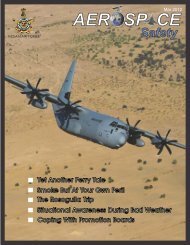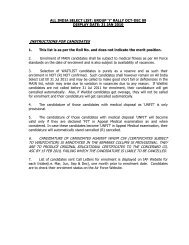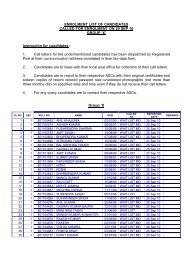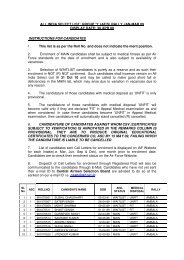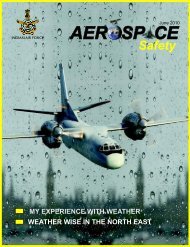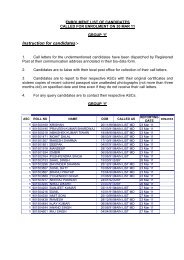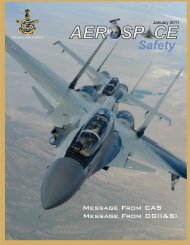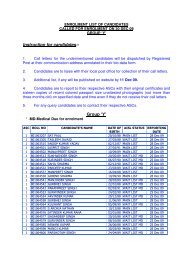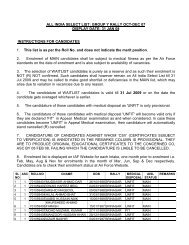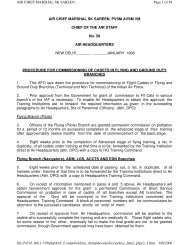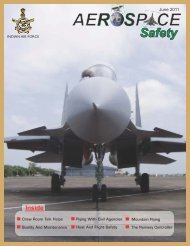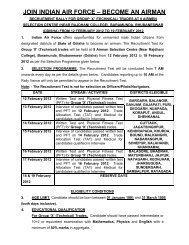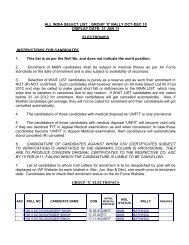February 2010 - Indian Airforce
February 2010 - Indian Airforce
February 2010 - Indian Airforce
You also want an ePaper? Increase the reach of your titles
YUMPU automatically turns print PDFs into web optimized ePapers that Google loves.
ONE day I was performing D Met O duties. In the<br />
morning briefing I had forecasted convective weather<br />
activity and thunderstorms in the afternoon/early<br />
evening hours based on the synoptic chart inputs.<br />
However, at around 1000 h, I noticed some dark patches<br />
appearing west of the base. I immediately requested the<br />
GCA for a weather report. In addition, I requested the DATCO<br />
to obtain air report from the pilots who were airborne.<br />
The GCA weather report confirmed that there were many<br />
cumulus patches in the SW direction. As the BADC missions<br />
were in air, I was told that the air report would be provided<br />
after landing of the first ac. While I was waiting for the aircraft<br />
to land, taxi-in, switch off and then obtain pilot’s weather<br />
debrief, the cumulus patches in the southwest grew in size<br />
and extent.<br />
I was now getting impatient by the second, in the<br />
absence of actual prevailing weather around the airfield and<br />
its actual build up. When I could no longer bear the threat of<br />
an occurrence of a thunderstorm over the airfield, I issued a<br />
weather warning giving a 30 mts warning time for the aircraft<br />
to recover. All aircraft in the local flying area were recalled<br />
by the DATCO citing deterioration in the weather conditions.<br />
Only when the first aircraft had landed and switched off in<br />
dispersal, I could talk to the pilot on the weather build up<br />
and its movement. By this time, all the aircraft had landed<br />
safely after having abandoned their missions.<br />
The pilot gave me a detailed debrief about the weather<br />
conditions. I, then learnt that the cumulus patches were<br />
growing but were moving in a northerly direction; thus,<br />
would have been clear of the base. I realized, I was wrong in<br />
estimating the direction of movement of the CB clouds, had<br />
issued the weather warning too early and now it was too<br />
late to retract the warning. Had I known that useful weather<br />
input 15 mts early, may be there would not have been loss of<br />
valuable flying training of the pilots.<br />
I am sure meteorologists face this kind of experience<br />
quite often. The importance of weather debriefs has been<br />
emphasized on numerous occasions. Meteorology is a<br />
growing science and brings about collateral benefits to<br />
us. Its importance ranges from utility services to space<br />
missions, from satellites to super computers and so on. Its<br />
role is ubiquitous. Such is its ubiquity that a day does not<br />
pass in most people’s life, when they directly or indirectly,<br />
consciously or subconsciously want to know the next day’s<br />
weather. Be it a flyer, farmer or a mere weekender.<br />
Despite its significance, it is the only science that is most<br />
ridiculed and at the same time respected. Generally, the<br />
reasons for failures in accurate forecasting are attributed to<br />
improper analysis. This is partly true, but most of the time it is<br />
lack of timely inputs in a rapidly changing weather situation<br />
that causes the failure in predictions.<br />
While we have a host of input channels for medium and<br />
long-range forecasts, for now-casting, there is no substitute<br />
to an air report that is given by a pilot in real time. All the<br />
conventional forms of input reception systems like land<br />
line channels, satellite products and internet sites provide<br />
us rather ‘stale’ data. We have not yet imbibed real time<br />
data reception methodology.<br />
At the time of need of real time input, it is from a pilot<br />
alone, that we get the best status of current meteorological<br />
conditions. In marginal weather conditions, the first sortie<br />
is usually carried out for weather reconnaissance at our<br />
flying bases. That amply proves the significance of such an<br />
input.<br />
By providing weather debriefs, the pilots can make the<br />
weathermen work in real time. Weather debriefs enlarges<br />
the scope of forecasting ability of the forecaster. It brings out<br />
distinct perceptional change among the weather brethren.<br />
In the sense, the weather debrief gives a meteorologist the<br />
most needed reaction time in ‘now-casting’. It has a learning<br />
value too. The weather debrief provides a forecaster the<br />
much needed confidence to either back his forecast or to<br />
amend it as necessary.<br />
Like wise, a true forecaster cannot become a master<br />
in his profession without having done some real time data<br />
analysis. The real time weather debrief input provides<br />
enough data to supercede the synoptic chart that is<br />
prepared at the end of a three/ six hour synoptic period<br />
(atleast for local forecasts).<br />
Recently there was a policy circulated by Air HQs<br />
regarding enlarging the observational envelope around the<br />
airfield for more accurate and timely short range forecasts.<br />
Field units were asked to conduct surveys of nearby civil/<br />
military establishments and liaise to establish a larger<br />
weather observation network. Whether shine or shower, let<br />
us institutionalize gathering of the pilot debrief even if it is<br />
a single sentence report about general weather conditions,<br />
as soon as the aircraft takes off, which would immensely<br />
help in providing a more conducive environment for flying<br />
operations. During flying, if pilots are busy, other aircrew<br />
like navigators, flight gunners etc can give debrief on the<br />
general weather conditions. This would immensely help<br />
the weathermen in understanding the intricacies of nature<br />
more objectively. Adherence to this would definitely<br />
increase the quality of the forecasts issued by the Met Flight<br />
significantly. I hope that the passing of weather debriefs by<br />
the aircrew become a routine in near future.<br />
JWO P Sriram Met Asst is posted to 414 AF Station.<br />
INDIAN AIR FORCE 2 01 0 F e b r u a r y Flight Safety 11



